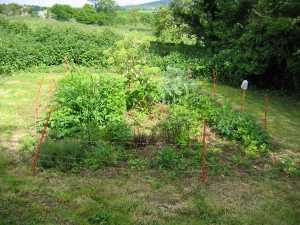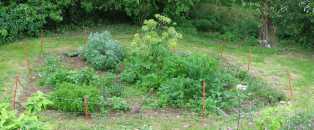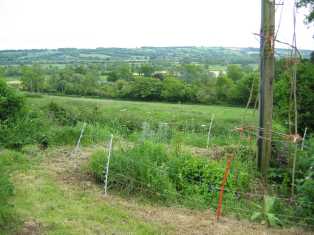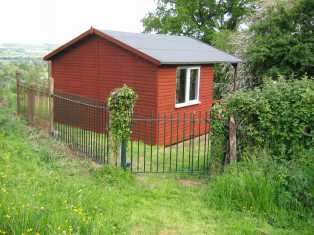|
|
May
2004

The photo above shows the lower herb
bed, looking out towards the view across the valley and
the Rissington Hills.
|
|
|
|

In the
photo above you can see the lower herb area |
|
|

The
photo above shows the upper bed and the magnificent, typically
English, countryside view you get from here. |
|
|

This
shows the approach to the summer house as you walk down the field,
and you can see the view of the english countryside beyond. |
13th
May - took a half day’s holiday from work to give a talk on herbs to Sutton
Coldfield United Reform Church “Thursday Group”. I picked a selection of
herbs from my garden and passed them round to the lively group of 25-30
pensioners. After they’d touched and smelt the herbs, I talked about the
different forms they could be used in, illustrating this with three
different kinds of tea, two tinctures and a couple of herbal vinegars for
them to taste. There were lots of comments and wry faces as they passed
round the tea-cups, but they were very interested and asked lots of
questions. One woman came up afterwards to talk about her recent operations
and I steered her gently towards consulting a qualified herbalist in her
local area by contacting the National Institute of Medical Herbalists.
May Bank Holiday - The glorious weather prompted another burst of frenetic
activity in the Cotswolds – painting the summerhouse, gate and railings,
general weeding and taking first cuttings from vigorous plants like back
horehound. The beautiful towering angelica was finally dying, so that was
also consigned to the hedge, in the hope that its seedlings will surprise me
next year. I spent much of Sunday afternoon and Monday morning mapping the
herbs, including those growing wild around the pond and making a list of all
the different varieties of trees within “The Sanctuary” boundaries. Oak,
crab-apple, hazel, elder, ash, willow and hawthorn had been added to by my
father when he first bought the farm in the late 50s and early 60s with
rowan and field maple and now I was adding my own ancient fruits with
mulberry, quince and medlar as well as more medicinal varieties - agnus
castus, gingko biloba, Balm of Gilead poplar and witch hazel.
At
11 o’clock May Bank holiday morning, the bees swarmed. The ferocious buzzing
drowned out any other noise and a huge black cloud of bees rose from below
the ash trees and circled their way down the fence before lifting over the
oak tree canopy and disappearing in a long, black stream into the distance.
It was an awesome sight tinged with sadness that the swarm would be lost and
there was nothing could be done about it. An email from the bee-man’s wife
that evening told us not to be dismayed. Bees are wild creatures and the
bee-man accepted that his bees would sometimes go towards improving the
stock of wild bees in a neighbourhood.
|
|
May summary report
Looking out at the mizzling rain today,
it is hard to imagine that the last three days have been so
glorious. I spent the Bank Holiday catching up on jobs down on my
parent’s farm, where I have my second herb garden. I spent some of
the time mapping out where all the different herbs and trees are
within the boundaries, so that I can leave diagrams for both my
parents “Which herb was it I was supposed to do something with?” or
anyone else who visits while I’m not there.
It was an interesting experience trying
to identify all the plants. For the life of me, I couldn’t find the
madder I know I planted at Easter and the woad I’d thought I’d
missed removing turned out to be an alecost, another new arrival
this year! I’ve also lost the mandrake I planted two years ago, but
the masterwort has reappeared after a year in hiding with two new
plants at the back of them. Maybe this year they will surprise me
and flower!
On the top herb bed, I trimmed back the
mugwort, which was threatening to overwhelm one of the three new hop
plants, which are slowly beginning to climb their custom built hazel
frame. I had to searched within the depths of the mugwort to
discover a few frail tendrils of St John’s wort and valerian
officinalis and it looks as if the marjoram has gone the way of all
flesh unless the flowers betray its presence later on in the summer.
The lemon balm is flourishing, unlike the large victim of frost down
in the bottom garden, as is the purple sage, which I meant to
harvest before I left, but forgot. The New England Aster are growing
well and hopefully next year I shall try drying the flowerheads and
adding them to my cough mixture or tincturing the darkest ones. The
little hedge of lavender had put forth tiny flower shoots which I
hope will provide scent for anyone brushing past. They are rather
overwhelmed by the yarrow and the Russian and common wormwood, which
are very dramatic with their silver foliage.
I have been very disappointed with the
yarrow. I bought some hoping to expand
my options for harvesting the local wild
population, which is quite scarce around
the farm, but last year it had no scent
or flavour, so I was loathe to use it.
This year, when I crushed some of the
leaves, the smell was a long time
coming, but was definitely there, so
perhaps it is growing stronger year by
year as it adapts to different
conditions. It is certainly flourishing
and will probably take over the whole
bed if I let it!
The final herbs (not mentioning the many
wild flowers which grow with out
permission! – white campion, red campion,
white dead nettles, thistles, nettles,
speedwell etc) are heliotrope, which
always reminds me of the faithful
governess in Elizabeth Goudge’s “A
Little White Horse” and her delicate
constitution and mullein. I’m hoping to
be able to dry the latter more
effectively this year as it went very
brittle and difficult to handle last
time. I’ve not dared to sacrifice a
living root to tincture yet as my access
to the plants has been so few and far
between, but it is supposed to be
wonderful for restoring slipped discs
and other back problems.
Along the fence, sheltered by a backdrop
of long grass, brambles, nettles and
other delights I have planted a gingko
biloba tree, an agnus castus and a
twisted hazel, which is finally growing
after two years of being eaten off by
invading lambs! The agnus castus must
like it’s new position because I could
swear it has grown at least six inches
so far this year! There is also a witch
hazel tree next to the swing, which I
originally bought because the trees are
being over harvested elsewhere. Now that
it is finally out of it’s protective
cage (it, too, had to survive being
eaten by enthusiastic, errant sheep!)
I’m surprised how much like an ordinary
hazel tree it looks as I was expecting
something far more exotic.
Around the summerhouse veranda there is
wall germander (bought originally
because it is a gout plant and my
husband developed that condition in his
hand before I learnt about the
contra-indications because of the
polyalkaloids which might cause liver
damage) which is on the Herb Society’s
list of endangered species. It is a
beautiful dark shiny green and in the
summer has deep blue spikes of flowers.
Next to the wall germander is my
solitary rosemary bush, as all the
others in the main herb garden were
caught in the February frost. It looks
quite healthy and seems to be growing
well, but I am worried that my weeding
will actually bring it and the
apothecary’s rose to the attention of
the rabbits, who might decide they like
the flavour!
At Easter, I decided to split the
marshmallow plant since it was never as
tall as the one in the home garden. The
two stalks by the summerhouse are
totally dwarfed by a stray aquilegia
which has self seeded, but the bees are
so enamoured of the nectar that I am
loath to pull it up just yet. The half I
transplanted to the banks of the stream
have shot up and look very healthy. I
don’t think the rabbits like them as
they’ve never been eaten off.
At the front of the veranda is an
enormous comfrey plant. I have stopped
making oils and tinctures from the
leaves and now try to use plantain for
all my “knit bone” needs. The bees were
going wild in the flowers and the green
and white of the comfrey against the
purple of the aqualegias was quite
stunning! I must have counted at least
six different kinds of bumble bees over
the weekend, from totally black ones to
a smaller variety with a lemon coloured
body.
I’ve planted an early flowering lavender
next to the seat by the main herb garden
and this year it has doubled it’s size.
It got badly eaten by something
(probably rabbits, maybe badgers) last
year and never really recovered. It’s
supposed to produce two lavender crops
if I cut it back hard after it flowers
the first time. The seat is in the shade
of a mulberry tree and I’m desperate for
it to start flowering and begin
producing fruit! Both the quince and the
meddler trees have flowed copiously this
spring and the quince still had a few
large white flowers that look like old
fashioned cottage roses. I’m hopeful
they will set and produce some
interesting fruit in the autumn.
When I counted the plants in the main
garden, it came to over thirty. There
are the usual culinary and medicinal
ones like thyme, sage, chamomile,
chocolate mint and chives, which are
there because there was nowhere else to
put them at the time, but most of the
herbs are ones I use regularly or am
trying to learn about. I have two sorts
of Echinacea –angustifolia and pallida,
but the pupurea always disappears when
my back is turned. The beautiful purple
coneflowers are so striking in the late
summer and autumn along with the yellows
and golds of the calendula, the white
fluffy flowers of the boneset and huge
pink Joe Pye Weed. The skullcap is
spreading nicely, which is great because
I used a lot of tincture last autumn
when my daughter was suffering. It is
one of the nicer tasting tinctures and
goes well in orange juice!
Unfortunately, the calendula have
decided to self seed where they felt
like it, rather than the bed I’d left
for them to grow in, so I planted out
the milk thistle seedlings into the
space instead! I’m hoping this year to
make more use of the leaves in salads as
they are supposed to be very nutritious
(once you remove the spikes with a pair
of scissors!).
The angelica is towering above
everything and the flower heads were
covered with all kind of insects. I’ve
decided to leave the seeds on the plant
this year in the hope that I’ll get some
seedlings coming up next year. I’ve
already taken off some leaves and hung
them up to dry along with some burdock
leaves from the wild plants which grow
around the pond. In the shade of the
angelica, I’ve planted Solomon’s seal
and wood betony, which seem to be quite
happy, as is the Chinese and ordinary
liquorice and agrimony. The hyssop is
producing a veritable hedge and I’m
looking forward to the blue flowers in
the summer. I’m just hoping it won’t
overwhelm the vervain by the side of it.
The motherwort and the goats rue are
vying for who can grow the fastest. The
motherwort has self seeded masses of
seedlings, which I would love to give
away. The pennyroyal and white catmint
are just about holding their own at the
very front of the bed.
Wormwood, black horehound and tansy are
three other plants which are running
rampant at the moment. I harvested the
black horehound (noticing it’s aweful
smell for the first time!) and the tansy
and they are both now hanging up to dry,
but the wormwood has been attacked by
blackfly quite badly, so I shall have to
wait and see what happens before I chop
it down. The white horehound looks a bit
leggy, so I shall wait a little longer
before I take the shoots for cough
mixture.
Amidst all the different shades of
green, the tiny tricolour flowers of the
heartsease look quite exquisite in the
early summer sun. It really does do your
heart good to see them as the birds sing
in the surrounding trees and the springs
trickle gently into the pond or down
into the stream. The black cohosh seem
to be growing well, with the delicate
leaves flickering in the breeze. A
couple of woad plants escaped my earlier
cull, but I have decided to leave them
alone for the moment. Their near
relations are flowering happily in a bed
of their own down by the bottom hedge.
The hawthorn sprays were dropping their
blossom on the grass all weekend and to
our amazement, the tree which had been
brilliant white a week ago was now a
deep shade of pink! We put it down to
the influence of the new beehive which
is situated close by. For the first time
in nearly thirty years, there are
flowers on the rowan tree, so we have
great hopes there will be red berries in
the autumn. There are eleven different
kinds of trees in the grove surrounding
the pond behind the herb garden,
thirteen if you count the wild
gooseberry and dogrose bushes. The elder
are the most numerous and will be
flowering soon, the great white pancakes
still green promises. Then come the ash,
hawthorn and crab apple, whose blossom
is already starting to set fruit. There
is also an eating apple tree and a Balm
of Gilead poplar, which seems too young
yet to produce the resinous leafbuds I
bought it for. The presence of two field
maples was a surprise, as was the self
planted young willow tree on the banks
of the pond, so slim compared with its
three ancient neighbours. Over them all
tower the two enormous oaks, with a
third oak leaning backwards on the lower
boundary. They are already over three
hundred years old and we hope that their
presence will protect the glade for
several hundred years to come.
It was hard to tear ourselves away from
such a beautiful and peaceful place. On
the Monday morning at 11 am, the bees
suddenly began to swarm. We watched them
swirl in front of the hawthorn blossom
before passing overhead in a deafening
buzz as they followed their queen away
into the vast unknown, grasping the
opportunity to return to a wild
existence amongst the fields and trees.
In my heart, I followed them, retaining
my freedom to roam even while I am
sitting in my office watching traffic in
the rain! |




